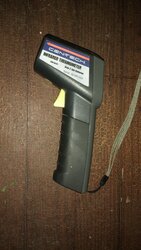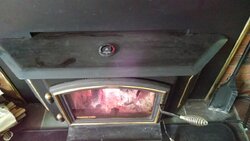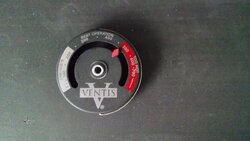I had a new liner put in.She has an insert with probably a liner. No pipe.
Overfiring
- Thread starter deborita3
- Start date
-
Active since 1995, Hearth.com is THE place on the internet for free information and advice about wood stoves, pellet stoves and other energy saving equipment.
We strive to provide opinions, articles, discussions and history related to Hearth Products and in a more general sense, energy issues.
We promote the EFFICIENT, RESPONSIBLE, CLEAN and SAFE use of all fuels, whether renewable or fossil.
You are using an out of date browser. It may not display this or other websites correctly.
You should upgrade or use an alternative browser.
You should upgrade or use an alternative browser.
If that spot is for sure the hottest on the stove face, being an insert keep it there and just read the numbers. No colors, no words. Just numbers.
Safe to go to 650. Gice yourself some room for overfire.
Thanks for the help!
Nick Mystic
Minister of Fire
I'm always surprised when we have one of these posts talking stove temperatures and people chime in telling the OP what temperature they should burn at and never ask what the stove manufacturer recommends. The placement of the thermometer makes a huge difference in getting accurate information on whether you are burning at the correct temperature for your particular stove. For example, on my Jotul F600 the manual says to put the stove top thermometer on the top of the stove in one of the corners to take temperature readings. When I do this on my stove I usually get a cruising temperature around 400 F. If I use my IR thermometer and take a reading at the center of the top I get a reading around 650 F. So, that means the stove is more than 50% hotter in the center than it is where the manufacturer says to take temperature readings. Now, when someone on the forum makes a blanket statement that running your stove at 700 F is okay they could be setting someone up for a severe over firing. In my case if I got a reading of 700 F on my corner mounted thermometer the center of my top plate could be over 1000 F if that same 50% increase held. So, people should always check their manuals to find the recommended location for taking temperature readings before they start to apply blanket statements on what temperature they should be burning at.
Woody Stover
Minister of Fire
You might want this info, too.. https://www.hearth.com/talk/threads/when-to-turn-down-the-air.171351/I am new to all of this
Ctwoodtick
Minister of Fire
Very true. FWIW, my Jotul insert only provides guidance to have any part of stove glowing. I’m guessing this is due to no easy access to top of stove for inserts.I'm always surprised when we have one of these posts talking stove temperatures and people chime in telling the OP what temperature they should burn at and never ask what the stove manufacturer recommends. The placement of the thermometer makes a huge difference in getting accurate information on whether you are burning at the correct temperature for your particular stove. For example, on my Jotul F600 the manual says to put the stove top thermometer on the top of the stove in one of the corners to take temperature readings. When I do this on my stove I usually get a cruising temperature around 400 F. If I use my IR thermometer and take a reading at the center of the top I get a reading around 650 F. So, that means the stove is more than 50% hotter in the center than it is where the manufacturer says to take temperature readings. Now, when someone on the forum makes a blanket statement that running your stove at 700 F is okay they could be setting someone up for a severe over firing. In my case if I got a reading of 700 F on my corner mounted thermometer the center of my top plate could be over 1000 F if that same 50% increase held. So, people should always check their manuals to find the recommended location for taking temperature readings before they start to apply blanket statements on what temperature they should be burning at.
ColdNorCal
Feeling the Heat
wooduser
Minister of Fire
I'm always surprised when we have one of these posts talking stove temperatures and people chime in telling the OP what temperature they should burn at and never ask what the stove manufacturer recommends.
I agree. Unfortunately, many manufacturers provide little or no guidance on the issue. They simply reserve the right to refuse warrentee coverage if a stove is "overfired" but don't specify reasonable conditions to avoid risk of overfiring.
So people are too often left to devising their own standards.
And it appears that manufacturer's should be well acquainted with what those standards ought to be, since testing and certification details how equipment operates. The manufacturers apparently prefer to keep their customer in the dark on this important issue.
ColdNorCal
Feeling the Heat
I agree. Unfortunately, many manufacturers provide little or no guidance on the issue. They simply reserve the right to refuse warrentee coverage if a stove is "overfired" but don't specify reasonable conditions to avoid risk of overfiring.
So people are too often left to devising their own standards.
And it appears that manufacturer's should be well acquainted with what those standards ought to be, since testing and certification details how equipment operates. The manufacturers apparently prefer to keep their customer in the dark on this important issue.
Having to email the manufacturer to ask such an important question makes one wonder why. Looking at the temps is something that happens several times during just one days burn cycle. Yet, no guidance in the manual. Certainly this lack of information is not to benefit the consumer.
wooduser
Minister of Fire
Ask the manufacturer where to measure and what temps are ideal. I emailed SBI asking about temps and their reply was to measure temps on stove pipe, 18" from stove top, with desired temps of 300-550.
Well, that's good. But why don;t they put information like that in their operating manual?
The cynic in me answers that they don't want to put that down in writing that people will be able to refer to, e-mails tending to be vaporous.
Unlike most other heating equipment, wood stoves operate under dramatically varying conditions, fuels, operators and such. Effective guidance on good operating parameters is badly needed, and most manufacturers let people down.
ColdNorCal
Feeling the Heat
Well, that's good. But why don;t they put information like that in their operating manual?
The cynic in me answers that they don't want to put that down in writing that people will be able to refer to, e-mails tending to be vaporous.
Unlike most other heating equipment, wood stoves operate under dramatically varying conditions, fuels, operators and such. Effective guidance on good operating parameters is badly needed, and most manufacturers let people down.
Read my post directly above yours.

I asked SBI about how to measure temps on an insert. This is the response:
"There currently is no easy way to monitor an insert. If a stove pipe thermometer is used you could likely look at temps on the front being approx.. 100-200f more than the pipe."
Last edited:
Easy Livin’ 3000
Minister of Fire
840° on my stove, per the manufacturer, at the the hottest spot on the stove. It's generally on top in the middle, right in front of the hole where the liner attaches. Probably inaccessible to you if you have a face plate over the surround.What temperature is considered over firing?View attachment 233625This is the temp of my stove right now. The thermometer is located on top of the stove above the door. Is this the right place to put it?
I recommend an infrared thermometer that would allow measurements around the door. Just point the "laser beam" (sharks not included) where you want to measure. They are cheap and nice to have. I've found measuring around the door to be a bit cooler than the hottest spot.
If you read 840, it's been over fired, so you'll want to keep it down quite a ways from there. I start to worry a little at 700.
Over time, you'll begin to recognize when you are headed there.

Last edited:
840° on my stove, per the manufacturer, at the the hottest spot on the stove. It's generally on top in the middle, right in front of the hole where the liner attaches. Probably inaccessible to you if you have a face plate over the surround.
I recommend an infrared thermometer that would allow measurements around the door. Just point the "laser beam" (sharks not included) where you want to measure. They are cheap and nice to have. I've found measuring around the door to be a bit cooler than the hottest spot.
If you read 840, it's been over fired, so you'll want to keep it down quite a ways from there. I start to worry a little at 700.
Over time, you'll begin to recognize when you are headed there.
View attachment 233772
I read the manual and it doesn't give the maximum temperature you can go to before over firing. I would definitely like to know. I have only been going to 500 jist to be safe because I don't know what is the highest temp I can go to without over firing it. If I can go higher than 500 that would generate me more heat. Someone on here said I could go to 700 than someone said all stoves are different. Not sure what temp to go to.
Your stove is safe to take up to 700º on the stove top.
840º is right below the temp where the steel will start to glow red. At that point the metal in the firebox will be exceptionally hot. While 840º may be in the mfg. listed safety zone it will be pushing the stove which will increase wear and stress if done many times or over an extended period. 700º is a safe and practical limit. If the stove occasionally peaks a little higher it's ok.
840º is right below the temp where the steel will start to glow red. At that point the metal in the firebox will be exceptionally hot. While 840º may be in the mfg. listed safety zone it will be pushing the stove which will increase wear and stress if done many times or over an extended period. 700º is a safe and practical limit. If the stove occasionally peaks a little higher it's ok.
Last edited:
Easy Livin’ 3000
Minister of Fire
They stopped putting the number in because of the lawyers. I had to find the number in an old manua,l before the lawyers got to them.I read the manual and it doesn't give the maximum temperature you can go to before over firing. I would definitely like to know. I have only been going to 500 jist to be safe because I don't know what is the highest temp I can go to without over firing it. If I can go higher than 500 that would generate me more heat. Someone on here said I could go to 700 than someone said all stoves are different. Not sure what temp to go to.
Problem is, most of us have the propensity to go right to the edge, just to have a look. And once you're reading 840 at the right spot, it's too late, because it's probably still going up.
Plus, too many people not reading at the right spot.
Now the manual just reads "Don't overfire".
All stoves are different. I got comfortable with 700, measuring at the right spot, with the right tool. Gives me plenty of margin for error.
Are you measuring at the right spot with the right tool?
They stopped putting the number in because of the lawyers. I had to find the number in an old manua,l before the lawyers got to them.
Problem is, most of us have the propensity to go right to the edge, just to have a look. And once you're reading 840 at the right spot, it's too late, because it's probably still going up.
Plus, too many people not reading at the right spot.
Now the manual just reads "Don't overfire".
All stoves are different. I got comfortable with 700, measuring at the right spot, with the right tool. Gives me plenty of margin for error.
Are you measuring at the right spot with the right tool?
They stopped putting the number in because of the lawyers. I had to find the number in an old manua,l before the lawyers got to them.
Problem is, most of us have the propensity to go right to the edge, just to have a look. And once you're reading 840 at the right spot, it's too late, because it's probably still going up.
Plus, too many people not reading at the right spot.
Now the manual just reads "Don't overfire".
All stoves are different. I got comfortable with 700, measuring at the right spot, with the right tool. Gives me plenty of margin for error.
Are you measuring at the right spot with the right tool?

 This is where I have it. Right in the center. The chimney guy told me to out it there. I would like to get the infrared gun and see what temperature I get.
This is where I have it. Right in the center. The chimney guy told me to out it there. I would like to get the infrared gun and see what temperature I get.Your stove is safe to take up to 700º on the stove top.
840º is right below the temp where the steel will start to glow red. At that point the metal in the firebox will be exceptionally hot. While 840º may be in the mfg. listed safety zone it will be pushing the stove which will increase wear and stress if done many times or over an extended period. 700º is a safe and practical limit. If the stove occasionally peaks a little higher it's ok.
Thank you. That's good to know!
wooduser
Minister of Fire
I read the manual and it doesn't give the maximum temperature you can go to before over firing. I would definitely like to know. I have only been going to 500 jist to be safe because I don't know what is the highest temp I can go to without over firing it. If I can go higher than 500 that would generate me more heat. Someone on here said I could go to 700 than someone said all stoves are different. Not sure what temp to go to.
I raised just this issue a week or so ago. Apparently, while manufacturers routinely disclaim warrentees if stoves are "overfired," few provide much guidance at what maximum operating temperatures they recommend. Fun, eh?
<<
At what temperature does steel glow?
Iron or steel, when heated to above 900 °F (460 °C), glows with a red color. The color of any heated object changes predictably (due to black body radiation) from dull red through orange and yellow to white, and can be a useful indicator of its temperature.

Easy Livin’ 3000
Minister of Fire
I think you have your answers: aim for below 700, and get an infrared thermometer ($20) so you can check out all the different spots, to learn.View attachment 233875 View attachment 233876 This is where I have it. Right in the center. The chimney guy told me to out it there. I would like to get the infrared gun and see what temperature I get.
https://m.harborfreight.com/hand-tools/thermometers/121-infrared-laser-thermometer-63985.html
I normally check just back from where you have your thermometer, because that's where I've found it to be hottest. Right before it goes under the surround.
Similar threads
- Replies
- 6
- Views
- 651
- Replies
- 32
- Views
- 3K
- Replies
- 2
- Views
- 464

